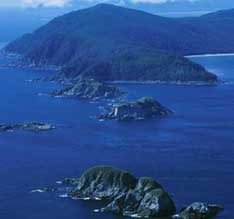Haida Gwaii : a 2009 Christmas present for Canada and its organic constitution
Dec 14th, 2009 | By Citizen X | Category: In Brief
Gwaii Haanas National Park Reserve: the southern tip of Haida Gwaii with the Kerouard Islands in the foreground and Kunghit Island in the background. Nick Didlick, Vancouver Sun.
This past Friday, December 11, 2009 the British Columbia government and the Haida First Nation signed a “broad-reaching land use and economic development agreement that included officially renaming the Queen Charlotte Islands with the traditional native name Haida Gwaii.”
The deal will strengthen the Haida First Nation in the regional economy of Canada’s Pacific Coast. And a “commitment to quantify carbon-offset credits” will help protect the forest that still haunts this magical group of more than 150 rugged islands off the British Columbia coast, 450 miles north of Vancouver (and “home to the Haida Indians for at least 8000 years,” along with Others from various other parts of the world more recently).
Officially renaming the Queen Charlotte Islands with the traditional native name Haida Gwaii also amounts to a welcome gift of the season for all of us who live in Canada today, from the Atlantic to the Arctic to the Pacific oceans. “Canada” itself is an aboriginal word – from the Iroquoian language spoken by the Canadian natives who first met Jacques Cartier, exactly 475 years ago this past spring and summer.
Haida Gwaii’s official renaming in this broader context might remind us as well of an article by the Osgoode Hall Law School professor Brian Slattery, first published in 1996 and somewhat ponderously entitled “The Organic Constitution: Aboriginal Peoples and the Evolution of Canada.”
Professor Slattery is an unusual academic. He has “devoted much of his scholarship to overhauling the standard conception of the Canadian Constitution in a way that takes account of the distinctive rights and historical contributions of Aboriginal peoples.” In his 1996 article he distinguished between an old-fashioned “Imperial Model” of our Canadian constitution, and a newer and more forward-looking “Organic Model,” which explicitly recognizes the contributions of Aboriginal peoples to what we all enjoy in Canada today.
(Or as Harold Innis, path-breaking historian of The Fur Trade in Canada: An Introduction to Canadian Economic History, explained back in 1930: “We have not yet realized that the Indian and his culture were fundamental to the growth of Canadian institutions.”)
The Organic Model, Professor Slattery urged in 1996, “opens up the Constitution to a variety of perspectives that have long been excluded or assigned to the periphery of our collective life.” And it finally “represents a further stage in the long process of decolonization that Canada has undergone since1867.”
For all Canadians the new official name Haida Gwai is another modest but important step forward in the long process of decolonization that we have been struggling through since 1867 (and, as Innis urged, even much before, if the deepest truth be known).
In the English language the islands were “first named after one of the ships of British Captain George Dixon in 1778, who called his vessel Queen Charlotte after the wife of King George III.” This old imperial history did no doubt make some significant enough contributions to what we enjoy in Canada today. But, like George III, its life is over now.
It is high time we started travelling back to the future of the organic modern Canadian constitution that we have all been working on for several centuries, Aboriginal and Others alike. Congratulations to BC Premier Gordon Campbell and Guujaaw, president of the Haida Nation, who signed the new agreement this past Friday.






[…] Here is the original post: Haida Gwaii : a 2009 Christmas present for Canada and its organic … […]